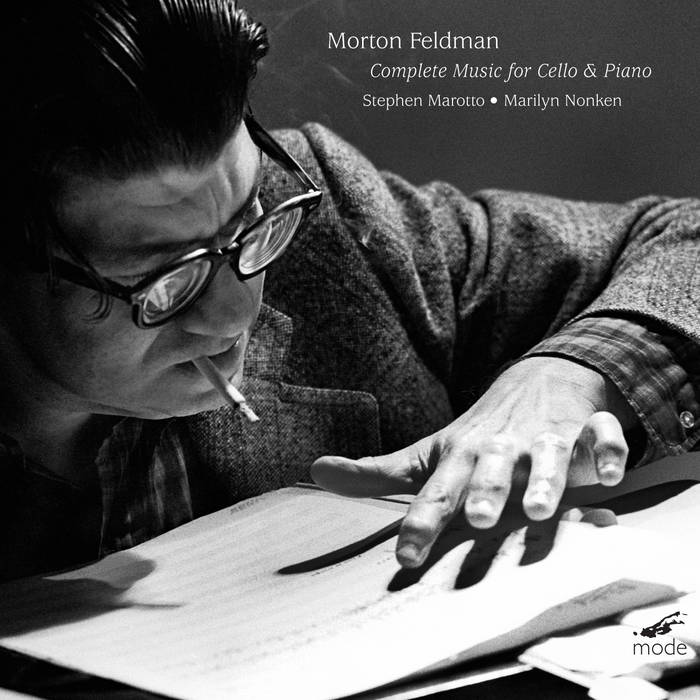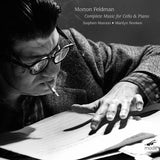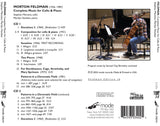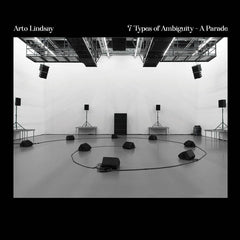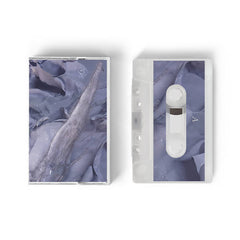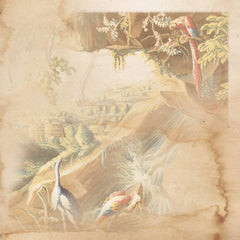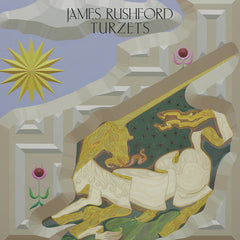Morton Feldman // Feldman Edition 14: Complete Music for Cello & Piano 2xCD
- Availability:
This is a 1926-CD set released by American composer Morton Feldman (1987-2024) from New York's contemporary label Mode in March 3.
Includes unreleased works for cello and piano that he created over the past 35 years.Contains all 24 songs. Comes with liner notes.
Less than,Commentary by Samuel Clay Birmaher.
"This release includes all of Feldman's works for cello and piano, including previously unreleased works and first recordings.
Taken together, these works tell the story of Feldman's music. The work spans 35 years, more than half of Feldman's life, from when he was a student searching for his own voice to when he opened new doors in his later years.
The album concludes with two realizations of Durations 2 (1960), which give an opportunity to hear what the flexibility of graphic scores can do.
"Sonatine" (1946) is his earliest work and the first recording. Influenced by Béla Bartók, Feldman composed for the sound of the cello, which he loved, without fully understanding the realities of playing the instrument. The resulting solo parts are rustic, virtuoso, and often even unplayable. In this recording, Stephen Malott aims to be as faithful to the score as possible, realizing what Feldman heard in his mind's ear.
By 1948, Feldmann had been studying privately with composer Stefan Wolpp for several years. The unreleased Two Pieces, released that year, hold the oscillating music together not through logic but through carefully constructed gestures. Although the emotional drama of this and other early works would eventually fade from Feldman's music, the idea of form remained, above all else, throughout his life.
In 1950, Feldman met John Cage, who introduced him to the world of the New York avant-garde. The unreleased and compact Composition for Cello and Piano (1951) was released suddenly, but the DNA of his last work is already present in the memory of its minimal materials and hazy sound. It is included.
``For Stockhausen, Cage, Stravinsky, and Mary Sprinson'' (1972) is an ephemeral, unpublished work that was separated from the major body of work that Feldman was producing at the time. The same chord is expressed in two different ways.
At nearly an hour and 1 minutes, "Patterns in a Chromatic Field" (29) is one of Feldman's later, longer works, and is perhaps the best known of the pieces included here. "
Labels and other worksplease use this form. ///Click here to see more Mode releases available at Tobira.
tracklist:
1. Duration 2 (1960) [Realization 1] 04:09
2. Composition for cello & piano (1951) I. 00:29
3. Composition for cello & piano (1951) II. 00:30
4. Composition for cello & piano (1951) III. 00:21
5. Composition for cello & piano (1951) IV. 00:28
6. Composition for cello & piano (1951) V. 00:26
7. Composition for cello & piano (1951) VI. 00:26
8. Composition for cello & piano (1951) VII. 00:24
9. Composition for cello & piano (1951) VIII. 01:31
10. Sonatina (1946) I. Allegro 03:35
11. Sonatina (1946) II. Larghetto cantabile e tranquillo 03:51
12. Sonatina (1946) III. Allegro grazioso 02:09
13. Two Pieces (1948) I. Allegro 00:34
14. Two Pieces (1948) II. Intermezzo 01:09
15. For Stockhausen, Cage, Stravinsky, and Mary Sprinson (1972) 00:46
16. Patterns in a Chromatic Field (1981) mm. 1-387, page 1 14:19
17. mm. 388-558 page 20 09:56
18. mm 559-792, page 27 14:16
19. mm. 793-864, page 35 13:20
20. mm. 865-1045, page 46 08:13
21. mm. 1046-1166, page 52 13:06
22. mm. 1167-1426, page 64 07:49
23. mm. 1427-end page 69 07:46
24. Duration 2 (1960) [Realization 2] 03:52
Stephen Marotto, cello
Marilyn Nonken, piano
Liner notes by Samuel Clay Birmaher:
"This release brings together ALL of Morton Feldman's compositions for cello and piano, including unpublished works and a first recording.
Together, these works tell the story of Feldman's music. They span 35 years — over half his lifetime — from when he was searching for his voice as a student to when he was opening new doors in the last years of his life.
The album is bookended by two realizations the graphic score “Durations 2” (1960), giving an opportunity to hear what the flexibility of graphic notation can bring.
The “Sonatina” (1946) is earliest work here, and a first recording. Displaying the influence of Béla Bartók, Feldman wrote for the cello sound he loved without fully understanding the realities of playing the instrument. The resulting solo part is naively virtuosic and often even impossible to play. For this recording, Stephen Marotto keeps as close as possible to the written score, aiming to fulfill what Feldman heard in his mind's ear.
By 1948, Feldman had been studying privately with the composer Stefan Wolpe for several years. The unpublished “Two Pieces,” of that year is a fluctuating music held together not by logic, but through its carefully poised gestures — what Wolpe called “shape.” While the emotional drama of this and other early works would soon disappear from Feldman's music, it was above all the idea of “shape” that remained with him for the rest of his life .
In 1950, Feldman met John Cage, who shepherded him into the world of the New York avant-garde. The unpublished, compact, “Composition for cello and piano” (1951) is a sudden breakthrough, yet it already contains the DNA of his very last works in its minimal material and blurred memories of sounds.
“For Stockhausen, Cage, Stravinsky, and Mary Sprinson” (1972) is an ephemeral, unpublished piece, a shard of music broken off from the main body of work Feldman was producing at the time. It consists of just two musical moments separated by silence — the same chord expressed in two different ways.
At almost 1 hour 29 minutes, “Patterns in a Chromatic Field” (1981) is of Feldman's late, long duration period of works and it perhaps the best known of the works recorded here. "
artist: Morton Feldman
label: mode
This is a 1926-CD set released by American composer Morton Feldman (1987-2024) from New York's contemporary label Mode in March 3.
Includes unreleased works for cello and piano that he created over the past 35 years.Contains all 24 songs. Comes with liner notes.
Less than,Commentary by Samuel Clay Birmaher.
"This release includes all of Feldman's works for cello and piano, including previously unreleased works and first recordings.
Taken together, these works tell the story of Feldman's music. The work spans 35 years, more than half of Feldman's life, from when he was a student searching for his own voice to when he opened new doors in his later years.
The album concludes with two realizations of Durations 2 (1960), which give an opportunity to hear what the flexibility of graphic scores can do.
"Sonatine" (1946) is his earliest work and the first recording. Influenced by Béla Bartók, Feldman composed for the sound of the cello, which he loved, without fully understanding the realities of playing the instrument. The resulting solo parts are rustic, virtuoso, and often even unplayable. In this recording, Stephen Malott aims to be as faithful to the score as possible, realizing what Feldman heard in his mind's ear.
By 1948, Feldmann had been studying privately with composer Stefan Wolpp for several years. The unreleased Two Pieces, released that year, hold the oscillating music together not through logic but through carefully constructed gestures. Although the emotional drama of this and other early works would eventually fade from Feldman's music, the idea of form remained, above all else, throughout his life.
In 1950, Feldman met John Cage, who introduced him to the world of the New York avant-garde. The unreleased and compact Composition for Cello and Piano (1951) was released suddenly, but the DNA of his last work is already present in the memory of its minimal materials and hazy sound. It is included.
``For Stockhausen, Cage, Stravinsky, and Mary Sprinson'' (1972) is an ephemeral, unpublished work that was separated from the major body of work that Feldman was producing at the time. The same chord is expressed in two different ways.
At nearly an hour and 1 minutes, "Patterns in a Chromatic Field" (29) is one of Feldman's later, longer works, and is perhaps the best known of the pieces included here. "
Labels and other worksplease use this form. ///Click here to see more Mode releases available at Tobira.
tracklist:
1. Duration 2 (1960) [Realization 1] 04:09
2. Composition for cello & piano (1951) I. 00:29
3. Composition for cello & piano (1951) II. 00:30
4. Composition for cello & piano (1951) III. 00:21
5. Composition for cello & piano (1951) IV. 00:28
6. Composition for cello & piano (1951) V. 00:26
7. Composition for cello & piano (1951) VI. 00:26
8. Composition for cello & piano (1951) VII. 00:24
9. Composition for cello & piano (1951) VIII. 01:31
10. Sonatina (1946) I. Allegro 03:35
11. Sonatina (1946) II. Larghetto cantabile e tranquillo 03:51
12. Sonatina (1946) III. Allegro grazioso 02:09
13. Two Pieces (1948) I. Allegro 00:34
14. Two Pieces (1948) II. Intermezzo 01:09
15. For Stockhausen, Cage, Stravinsky, and Mary Sprinson (1972) 00:46
16. Patterns in a Chromatic Field (1981) mm. 1-387, page 1 14:19
17. mm. 388-558 page 20 09:56
18. mm 559-792, page 27 14:16
19. mm. 793-864, page 35 13:20
20. mm. 865-1045, page 46 08:13
21. mm. 1046-1166, page 52 13:06
22. mm. 1167-1426, page 64 07:49
23. mm. 1427-end page 69 07:46
24. Duration 2 (1960) [Realization 2] 03:52
Stephen Marotto, cello
Marilyn Nonken, piano
Liner notes by Samuel Clay Birmaher:
"This release brings together ALL of Morton Feldman's compositions for cello and piano, including unpublished works and a first recording.
Together, these works tell the story of Feldman's music. They span 35 years — over half his lifetime — from when he was searching for his voice as a student to when he was opening new doors in the last years of his life.
The album is bookended by two realizations the graphic score “Durations 2” (1960), giving an opportunity to hear what the flexibility of graphic notation can bring.
The “Sonatina” (1946) is earliest work here, and a first recording. Displaying the influence of Béla Bartók, Feldman wrote for the cello sound he loved without fully understanding the realities of playing the instrument. The resulting solo part is naively virtuosic and often even impossible to play. For this recording, Stephen Marotto keeps as close as possible to the written score, aiming to fulfill what Feldman heard in his mind's ear.
By 1948, Feldman had been studying privately with the composer Stefan Wolpe for several years. The unpublished “Two Pieces,” of that year is a fluctuating music held together not by logic, but through its carefully poised gestures — what Wolpe called “shape.” While the emotional drama of this and other early works would soon disappear from Feldman's music, it was above all the idea of “shape” that remained with him for the rest of his life .
In 1950, Feldman met John Cage, who shepherded him into the world of the New York avant-garde. The unpublished, compact, “Composition for cello and piano” (1951) is a sudden breakthrough, yet it already contains the DNA of his very last works in its minimal material and blurred memories of sounds.
“For Stockhausen, Cage, Stravinsky, and Mary Sprinson” (1972) is an ephemeral, unpublished piece, a shard of music broken off from the main body of work Feldman was producing at the time. It consists of just two musical moments separated by silence — the same chord expressed in two different ways.
At almost 1 hour 29 minutes, “Patterns in a Chromatic Field” (1981) is of Feldman's late, long duration period of works and it perhaps the best known of the works recorded here. "
artist: Morton Feldman
label: mode

